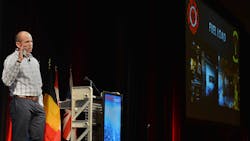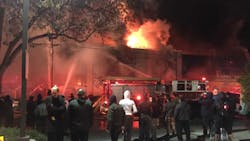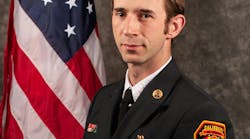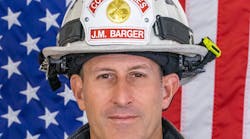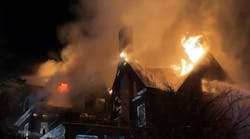The burden of incident command weighs heavy on fire officers even when lives don't hang in the balance, and for Battalion Chief James Bowron, the weight he carries from the deadly Ghost Ship fire is evident.
Bowron took the main stage Wednesday evening at Firehouse World in San Diego to discuss the crucial command role he played in tackling the blaze at the warehouse-turned-artist's collective on Dec. 2, 2016, in Oakland, CA, that claimed the lives of 36 people.
The Ghost Ship
The warehouse in the Fruitvale neighborhood of Oakland was a two-story cinder block building built as a creamery in 1930 that was roughly 10,000 square feet. Steel trusses covered by wood sheathing made up the roof of the structure, which was converted into an artist's collective by its master tenant, Derick Almena.
Almena had filled the building with pieces of artwork and musical instruments—he had an affinity for old pianos—and covered every piece of wall space with various items he'd collected while also creating small living quarters for tenants whom he charged a fee to live there. Wooden palettes were used to fashion a staircase up to the second floor mezzanine and to separate the small spaces the renters occupied.
"He put these small little trailers inside the building and then sublet these trailers out to people," said Bowron. "He had something screwed, welded, tacked, hammered or nailed to every square inch of that building."
The fuel load inside was nothing short of incredible, there were no sprinklers or smoke alarms and the interior was situated like a maze that was very difficult to navigate. Simply put, it was a disaster waiting to happen.
"Everything was kind of like a labyrinth and everyone had their own cubicle space made out of palettes, made out of doors," Bowron said.
Getting the call
On the night of Friday, Dec. 2, 2016, Almena and another Ghost Ship tenant, Max Harris, hosted a party at the building that was attended by anywhere from 50 to 100 people, most of whom had congregated on the second floor where there was a dance floor.
At some point during the party, an electrical fire broke out on the first floor beneath the dance floor, but the party attendees were initially unaware of it.
The Oakland Fire Department was dispatched just before 11:30 p.m. when calls began coming in, and people in the area had also rushed over to Station 13 a few blocks away and began banging on the apparatus bay doors to alert the firefighters inside to the blaze.
Bowron was one of the first to arrive on scene and took command of the fight.
"We had three engines, a truck and a chief on scene in the first five minutes from dispatch," Bowron said. "The fortunate thing was we had a water supply and the engine was able to take a lead and have water right away."
"As I was doing my 360, what I could see was that the only access into this building was a man-made door that was cut out of a commercial roll-up. And it's not like it was a clean door that was welded up all nice and neat."
Going on offense
The initial attack involved running a pair of hoselines through this door, but heavy smoke made visibility almost zero, and crews on scene were still not sure how many people or if any at all were inside the building.
"When I talked to the engine companies, they were only able to get about 15 or 20 feet through the door and were already getting smoke conditions that were terrible. They were running into pianos and having a hard time trying to make their way in."
Bowron's main focus given the difficulties with gaining entry was to keep the fire contained to the warehouse and avoid losing the whole block to the blaze, and he quickly struck a second and then a third alarm.
"As I'm making my way toward the alpha side and toward the bravo side, I'm getting people coming up to me and they're telling me, 'Hey, there's people in there,' and I'm just trying to take it in and make sure I can stay task focused and get my lines placed and my people placed."
It was then that Bowron went with the very difficult decision to not make an announcement to his crews over the radio that there were 50 to 75 people reported to be inside. "Had I made that announcement that there might have been 50, 60, 70 people in there, my crews—which had already pushed and pushed and pushed as hard as they could— would have probably made decisions or pushed themselves to a further limit which may have caused potential loss of life for the fire department on our end."
It's an operational decision Bowron says he understands some might question, but he remains steadfast that he did the right thing.
"Looking at the smoke conditions and the probability, the survivability of what the smoke was doing, if we were going to find anybody, they were going to be in that initial 25 to 50 feet from the front door and the initial hose stretch."
With two truck companies on the roof working on top-side ventilation, Bowron knew if the already deep-seated fire got into the second floor that he would have to pull back.
"This was like no fire I had ever been to before. And not just because we had 36 fatalities, but the sense of calm that was on scene when I got there was super eerie," Bowron said. "There were people everywhere ... and I'm running around and no one is saying anything."
"Everyone in that crowd was stone silent and it was really weird."
A defensive posture
Bowron noticing the silence in the crowd is important because a moment came when he turned away from the building and then heard a collective gasp from the people watching the blaze unfold about 22 minutes into the incident. The fire suddenly began to light up the night sky, and Bowron's primary concern was that they had just had a flashover.
"What I began to see was a huge change in fire conditions," Bowron said. "And then the mental gymnastics begin and I think, 'Oh my gosh, I just lost four companies. ... In that five seconds when I couldn't get a hold of anybody inside, it's amazing the stuff that can run through your head."
The aggressive fight from the interior and the hope of finding survivors gave way to Bowron's next strategic decision to go defensive, which came after his truck crews informed him that the fire was well involved on the second floor and smoke began "blowtorching" out of the roof after 29 minutes.
The decision to pull back indeed proved correct when the roof collapsed.
"Now that we were defensive, I had the ladder hoisted up, two-and-a-half in place, and we were going with surround-and-drown, just kind of preparing ourselves, but I'm still not sure how many people are in there."
The sheriff's son
The emotional roller coaster Bowron was on kept coming when he was approached by a police officer assisting with crowd control who handed him a piece of paper with 60 names on it. They were people who were all unaccounted for.
"I knew (the possibility of fatalities) was there, but now I actually had some confirmation and a list in my hand," Bowron said. "It hit me pretty hard."
It was then that an Alameda County sheriff walked up asking questions about where the people who had escaped the building had been taken. Bowron informed the man of people being moved to a nearby parking lot and a few hospital transports, all the while watching his posture begin to sag.
It turns out the officer's 17-year-old son had been inside, and the boy wasn't at any local hospitals or answering phone calls or texts.
Aftermath
The incident was placed under control at around 4:36 a.m. on Saturday, Dec. 3, before the difficult work began of locating victims. Crews had to first stabilize the structure and then spent days removing all the debris inside to locate what turned out to be 36 bodies instead of 60.
All but one of the victims never made it off the dance floor on the second level, having been overcome by smoke.
"It was definitely overwhelming for my department and overwhelming for myself, especially after being there from the onset," Bowron said.
Almena and Harris are awaiting trial on 36 counts of involuntary manslaughter because of the unsafe conditions they allowed to fester inside the building and for their actions in running the shoddy electrical lines that powered the interior and ultimately caused the fire.
The incident was the deadliest structure fire in Oakland's history and the worst in the country since the 2003 Station Nightclub fire in Rhode Island that killed 100 people. It was also Oakland's deadliest mass-casualty event since 42 died in the 1989 Loma Prieta earthquake.
One of the most important lessons Bowron says he learned from this tragedy is the importance of peer support and his colleagues being there for each other to help process and recover from such a difficult event.
"It's important that we talk to people and get it out there," Bowron said. "Bottling it up, it just doesn't work. ... This can't be the normal for us. We've got to make sure that we're taking care of each other. We've got to make sure that we're looking out for each other."
